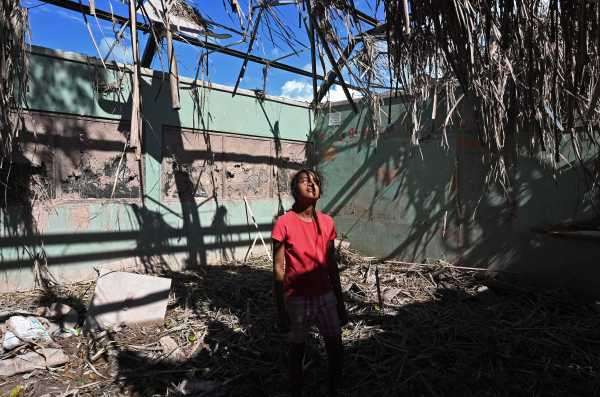
Republicans are eager to decry a “Biden border crisis.” But the current wave of migration at the southern border is the result of a humanitarian crisis in Central America that has been years in the making.
Citizens of the “Northern Triangle” region — Guatemala, Honduras, and El Salvador — have long suffered from gang-related violence, frequent extortion, government corruption, and high levels of poverty. Over the past few months, though, another factor has added an additional push to make the dangerous journey north: continuing devastation from back-to-back hurricanes.
Hurricanes Eta and Iota, both super-powerful Category 4 hurricanes, made landfall in November 2020 within a two-week span, ripping through Nicaragua, Honduras, and Guatemala. The storms brought torrential rain and resulting flash flooding and landslides. They left more than 200 people dead and another 5.3 million people in need of assistance, including more than 1.8 million children, according to Unicef’s estimates. Many families lost their homes, their belongings, and access to water and livelihoods.
The hurricanes delivered yet another shock to a region that already experienced the highest levels of violence and poverty in the world and was facing an economic downturn from the Covid-19 pandemic.
“It’s concerning that many parents lost their jobs because of the pandemic and then lost their belongings, houses, and crops because of the hurricanes,” Laurent Duvillier, a spokesperson for Unicef’s Latin America and Caribbean regional office, said. “These children and their families are now left with very little food, very little safe water, and very little money to survive.”
In the four months since the hurricanes, recovery has been slow. Most families have left official shelters to return to their communities where rehabilitation work has started but living conditions and access to services and income have heavily deteriorated. More families continue to be pushed into poverty and, absent urgent action, more children are likely to become malnourished and drop out of school. Agricultural communities hit by the storm are also only beginning to see the impacts of last season’s crop failures.
All of this, experts say, is helping push migrants out of their home countries and toward the US.
“The push factors are really gonna pile up, even at just a really primitive level of food insecurity in areas of that country that aren’t used to that,” said Kaleb Eldridge, who is working to deliver aid to agricultural communities impacted by the storm with the nonprofit Heart to Honduras. “It’s just going to squeeze tighter over the coming months.”
The road to hurricane recovery is still long
The process of recovering from the storms has been slow and incomplete.
“Crises in the region are not felt just once, they are felt repeatedly and for years,” Duvillier said. “The humanitarian needs of children and their families will persist as the needs will change over time due to the long-term impacts. Generations to come will live with the impacts of the pandemic including a socioeconomic decline, increase in natural disasters, forced migration, and violence.”
Kayly Ober, a senior advocate and program manager for the Climate Displacement Program at Refugees International said that when storms of such magnitude have hit the region in the past, there is typically a rural-to-urban migration push so that people can participate in economic opportunities that aren’t tied to the weather. But because of Covid-19, opportunities in the cities are limited at the moment.
Many of the subsistence farmers he works with in Santa Barbara, a region in the northwest of Honduras, had previously held factory jobs in the city of San Pedro Sula, Eldridge said. But during the pandemic, they were laid off and forced to return to rural areas of the country.
The hurricanes came at the moment of their harvest, which would have been larger than usual, Eldridge said. Based on a survey of farmers across the four subsistence agriculture communities he works with, they are observing a 40 percent loss of corn crops and 65 percent loss of bean crops. They will only suffer more acutely in the coming months as their food stores run out and their income loss means they have little to fall back on. Farmers of cash crops such as coffee have also lost about half of their crop because the beans fell off the plants during the storm.
The Famine Early Warning System has projected that food insecurity will consequently ramp up in Honduras from now until August or September.
“We’re working with them on a plan to mitigate the worst of that in the coming months, since they lost a lot of their seed stock and they’re not going to be in an economic position to be able to buy fertilizer or any other agricultural inputs,” Eldridge said.
Some families are also still experiencing displacement from areas that were affected by the storm. Eldridge is working on rehousing 16 families who were in an area that experienced a landslide that killed a grandmother and her three grandchildren.
There are also ongoing infrastructure problems. More than 1.5 million children continue to be exposed to life-threatening diseases due to contaminated water systems, including wells and latrines. More than 1,200 schools have been partially damaged or destroyed, some of which were still buried under sand or covered by mud when Duvillier visited in January.
The hurricanes have also made it harder to access roads. In one community in Santa Barbara, powerful landowners consequently built private roads through their properties and started charging people who had no other means of travel for access, Eldridge said.
The ongoing challenges in countries affected by the hurricanes have made the prospect of fleeing north more attractive — and people who have been waiting for the right moment to do so see an opportunity in the change of administration in the US to one that has taken a more humane approach to migration.
Eldridge said that he was surprised by how savvy people even in small, rural towns are about changes in US immigration policy and how it might affect their chances of successfully crossing the border. (At this point, the Biden administration is still turning away the vast majority of migrants arriving at the border on pandemic-related grounds, but it is accepting unaccompanied children, asylum seekers who were sent to Mexico under the Migrant Protection Protocols to await their day in court in the US, and some families with young children that Mexico has refused to take back.)
“Many families have nothing to go back to and are now left with little options to survive. Unless more humanitarian support is provided to Central American countries affected by these tropical storms, unless conditions are created in communities for people to be able to stay, it is expected that more families will migrate north in search for a better future for their children,” Duvillier said.
International aid has been insufficient
While humanitarian agencies have been on the ground rebuilding, the international response hasn’t been sufficient to get the affected countries back to their pre-hurricane baseline.
Unicef has received only about 35 percent of the $42.6 million they requested in December to provide humanitarian assistance across the region. (Most of the agency’s funding comes from governments or other public-sector actors, and its top contributor is the US government.)
The US level of intervention has been limited compared to how it has reacted to natural disasters in the region historically. When Hurricane Mitch made landfall in Central America in 1998 and caused more than 11,000 fatalities, the Clinton administration spent roughly $956 million on relief efforts and deployed more than 5,000 civilian and military personnel to the region. Some 60,000 citizens of Honduras, which was the hardest hit by the hurricane, were also granted Temporary Protected Status and allowed to live and work in the US free of the fear of deportation.
This time around, there hasn’t been the same kind of humanitarian response, Ober said. That is partly because the storms hit when former President Donald Trump, who had pulled humanitarian aid from the region, was still in office.
But even the Biden administration is “trying to pick and choose at this moment early on where it wants to set its targets and where it wants to use its political capital,” she said. President Joe Biden has proposed a $4 billion aid package to Central America, but Ober said that it’s more concerned with preventing migrants from heading north.
“I don’t think that the way in which they view the region is necessarily with a humanitarian lens at the moment,” she added. “It’s one of migration containment or pushback, rather than acknowledging that migration may be a viable way to adapt in a changing climate and especially post-disaster. We have to have a just, humane immigration system that acknowledges that in order to facilitate movement where it might be necessary.”
Climate events will continue to drive migration from Central America
Hurricanes Eta and Iota are part of a broader trend of climate-related events that have pushed Central American migrants northward.
The Northern Triangle goes by another name: Central America’s “Dry Corridor.” The region has seen below-normal rains in recent years leading to severe drought as a result of fluctuations in El Niño, the climate phenomenon that occurs about every three to five years when temperatures rise in the tropical Pacific Ocean. The Food and Agricultural Organization estimates that 3.5 million people have faced food insecurity over the last decade due to these droughts.
People who have decided to flee as a result are what could be called “climate refugees,” though the US and other developed countries don’t officially recognize them as such. The US currently only accepts refugees who have been targeted based on their race, religion, nationality, politics, or affiliation with certain social groups, but not those displaced by climate change. While 164 countries signed a United Nations agreement in 2018 to work together to resettle those kinds of migrants, the pact is not legally enforceable and depends on voluntary participation.
That could change. The United Nations issued a landmark decision in January 2020 recognizing that deporting migrants back to countries facing an immediate threat stemming from the climate crisis would “expose individuals to a violation of their rights.” And some Democrats have pushed to create a “climate refugee” category, including former 2020 Democratic presidential candidate Julián Castro.
As climate change threatens to displace tens of thousands of people in areas that will become uninhabitable in the coming decades, creating a mechanism by which the US can offer them protection will be critical. So too is investment in disaster risk reduction measures, more resilient infrastructure, and alternate economic opportunities in Central America.
“This is not the first hurricane hitting these countries along the Caribbean Coast; and unfortunately, it’s not going to be the last one,” Duvillier said. “It’s unfair that children from the poorest communities across Central America are the least responsible for climate change, yet they are bearing the greatest burden of its impact.”
Millions turn to Vox to understand what’s happening in the news. Our mission has never been more vital than it is in this moment: to empower through understanding. Financial contributions from our readers are a critical part of supporting our resource-intensive work and help us keep our journalism free for all. Help us keep our work free for all by making a financial contribution from as little as $3.
Sourse: vox.com





